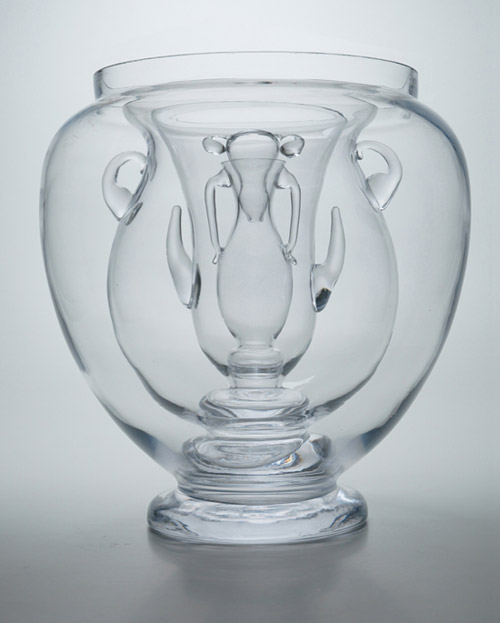The Archetypal Vase is a set of five interconnecting glass vases designed by Andrea Bandoni and Joana Meroz, born from their research project The Object Without a Story which suggests that the stereotypical text accompanying conceptual design objects is entirely systematic. The designers discovered sentence patterns and word clusters that were repetitiously used in the marketing of design objects. From a re-production Bauhaus lamp to Marcel Wanders newest sofa, specific words and phrase types are re-cycled over and over. Rather than simply assuming this indicates a stagnation in the artistry of copy writing, although it probably does, Bandoni and Meoz present evidence that the stories tended to fall into four categories or archetypes.
“Are we looking at a world with subtitles?“
The implication is that production of these stories is in fact mechanistic, and that they are intuitively used by designers, PR people, writers, critics, curators etc. because they are sub-consciously assumed to work. Bandoni and Meroz then extrapolate the mechanism into a formula which can generate multiple and arbitrary stories. Their vase is therefore presented as not as having a single story, but multiple; generated by this formula and corresponding to the archetypes they uncovered.
“We found that 100% of designers believe the story interferes in the perception of the object.“
The vase presents five layers of visibility: and the accompanying stories manifest as layers of glass. One is on the outside, and one on the inside, and 3 in between. All are seen. The metaphor of transparency is paramount, and we can sense the transparency of the stories as conceptual devices. The materiality is precise; the use of glass reflects the highly controlled formation of an idea which is both poetic and brittle; that a story can express truth. The stories presented here bite into one another, leaking away their opacity and exposing the structure of the whole.
“The story can be used as a walking stick“
Bandoni and Meroz makes a position that the vase devalues all stories, however, at its heart, there is a powerful meta-narrative at play. The title “The object without a story” is a misnomer; the object has many, and far more than the four or five. There is a story written in the blog posts: and also written in the research paper. There is the story of how Bandoni and Meroz used statistic analysis to dissect the stories used to sell and market conceptual design. There is a story also in the workshop Meroz conducted in Poland, mixing up designers, authors, stories and objects into random combination, and there is story in the production of the vase itself – part of that story is the apparent strangeness of having the mould made in a Czech glass factory, but the glass blowing in a Dutch one. The mechanically generated stories are also important – while seemingly arbitrary they are designed to stimulate subjective interpretation.
“Stories don’t reveal the truth about an object but we are still obsessed with them.“
The final story is the one that forms when jumbling the visual information one gets from looking at the vase, with the textual information one gets from reading about the vase. Much in the same way the glass of the each vase is is structurally separate, but visually interrelated, the stories of the vase are discrete narrative entities making up a meta-narrative which can be subconsciously constructed and intuitively felt. The real story is that all objects have different narratives depending on the personal way you tilt your head to look at it. It forms when we open our mouths to speak at a gallery or when look up from our magazine at the cafe: we are obsessed with stories because they represent creation, and we are constantly and sub-consciously making them in our minds. But the nice thing about story creation is also its problem; we are rarely aware we are doing it – the formation is intuitive. And in the mire of laziness, we re-produce rather than produce. Intuition can be like the leak of light to a blind man who otherwwise must think with his fingers, but we don’t always interpret this glimmer as creatively as we should. When it comes to thinking about the objects with which we fill our lives, mostly we are just groping around in the dark.
This is what Bandoni and Meroz present; mechanistically produced stories have less value. Subsequently, they make the position that the viewer should form their own story about the vase. Once we do, we realise we have circumvented the conventional process of understanding design, which itself becomes the story. The meta-story is now awake, and made tactile and concrete via the synthesis of construction and material into a set of, really nice, blown glass vases.
All quotes from “Narrative Objects/From Vormgever to Woordgever” by Andrea Bandoni and Joana Meroz.
Photo by Susana Camara Leret
THE OBJECT WITHOUT A STORY is now available at THE FROZEN FOUNTAIN
Opening: Saturday 19 September, 17:00 > 19:30, 2010, Prinsengracht 645 – Amsterdam

